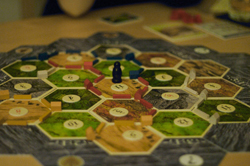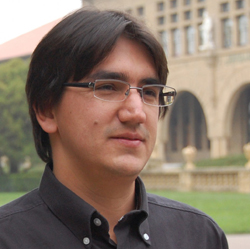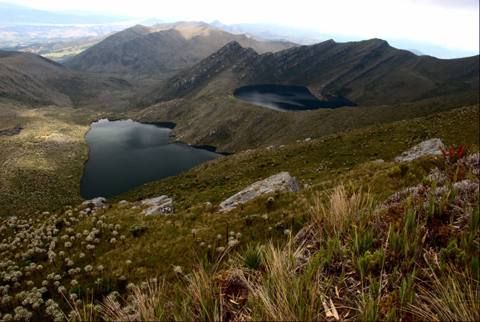Science, Upstream: On board games and resource management
The hexagonal world of Die Siedler von Catan, with its little wooden cities and its alluring rock quarries and wheat fields, first appeared on my radar in 2006, when I was a senior in college. Since then, the English version of the board game has exploded in popularity, and I’ve spent countless nights in Portland, Ore., and the Bay Area negotiating transactions around limited imaginary resources – with the consistent goal of monopolizing them and thereby hosing (technical term) my Settlers compatriots.
Juan Sebastian Lozano Velásquez, an ecologist with The Nature Conservancy in Bogotá, Colombia, doesn’t share my passion for Settlers. In fact, until we met on the Stanford campus a few weeks back, he’d never heard of the game. But he was introduced to what you might consider a real-life application of it while he was an undergraduate student at the Javeriana University in his native country. There, he helped run an economics experiment looking at how people make decisions about common-pool resources, such as fisheries, when they have actual money at stake.
“It was a mess,” he says. “Everyone was of course harvesting very high” to maximize individual profit, rather than moderating their impact on the ecosystem to achieve some theoretically possible collective benefit.
Conducting the experiment, Lozano says, had the same effect on him that chronic Settlers playing has had on me: We both think a lot more
(As Marc Conte clarified for me, the theory maintains the lack of property rights incentivizes over-harvest because anything left unharvested will most likely be claimed by someone else.)
Lozano, who recently spent two weeks on the Stanford campus to train with Conte and others in Natural Capital Project, is now helping lead a different kind of economics experiment. He’s running the hydrologic component of NatCap’s InvEST software in Colombia to identify areas that would benefit most from conservation efforts. And although InVEST doesn’t explicitly address the issue at the heart of the tragedy of the commons – undefined property rights – it certainly combats some of the phenomenon’s destructive effects. The software seeks to align economic self-interest with conservation by giving worth to variables (dubbed “ecosystems services”) that are too often ignored in decisions about land-use and consumption.
(The Nature Conservancy is working on several projects in Colombia and neighboring Ecuador. Lozano is helping with the “Save Bogotá’s water” campaign – an effort to protect the watersheds around the city through the intelligent distribution over the next ten years of money from a projected $60 million conservation trust fund.)

1. Identify goal. Is the objective to identify areas that are capable of producing the most water for drinking and hydropower? Or is it to identify areas that are contributing the most contaminants or clogging sediments to a reservoir? In Colombia, Lozano says, The Nature Conservancy’s goal is to protect high-altitude areas, where the roots of native vegetation store and filter water, allowing it to trickle out slowly to satisfy dams and reservoirs during dry summer months.
2. Find data on soil type, climate and land use. Start with published maps and datasets, and ground-truth the data where necessary. (Verifying written information is especially necessary when considering land use, which – thanks to human creativity – changes so drastically over short distances and periods of time).
3. Apply geostatistical methods to spread spotty data uniformly across the area of interest. “Maps work like a big grid, where each cell has a different value,” Lozano explains. Mathematical functions help to fill in cells where information on evapotranspiration, for instance, might be missing. By considering related variables like precipitation, sunlight and vegetation type, InVEST helps fill in values for this important process through which plants essentially pump water vapor from the ground into the air.
4. Run scenarios and compare outputs. Contrast current scenario with scenarios that reflect hypothetical modified land-use patterns. “Say you own a hydropower plant, and you’re having trouble during the summer because the low level of water is hindering your hydropower production, ” Lozano says. What would be cheaper: conserving natural vegetation so it would sponge up water during the rainy months and make it available in the summer, or possibly going so far as to abandon the site altogether? As Conte explained in our introduction to the natural capital concept, the group’s dedication to a hard-headed, economic approach means conservation doesn’t win out 100 percent of the time. “Sometimes it’s just much better to leave the hydropower plant and go build another one somewhere else,” Lozano says.
5. Make recommendations. “Of course we have two kind of outputs,” Lozano says, “one for policy makers and one for the guy who has money.” This part of the process is “very cool,” he adds, because it enables researchers to talk to stakeholders in their native tongue. When dealing with landowners “who have a lot of money but don’t have any knowledge about ecosystems or water production,” Lozano sees great value in being able to walk into a meeting armed with an arsenal of cold, hard data. “You go there and you tell them, based on these predictions and this information, the areas you should preserve are this and this and this and it will cost you X amount of dollars,” he says.
Lozano is aware that the InVEST approach to conservation is controversial. The work he’s doing, he says, could generate a “big discussion” about whether we should be assigning ecosystems economic value, “just reducing them to the money.” Or should we instead think about ecosystems as important areas just intrinsically, he wonders, “just because…”
“But that’s another discussion,” he says. “A very long one.” It’s a discussion we intend to have soon here on Science, Upstream. But for now, Lozano is focused on the task at hand: letting the knowledge he sponged up during two weeks on the Stanford campus trickle out to help grow nascent conservation efforts in Ecuador and his native Colombia. And I, for my part, will be focusing my efforts on a cause dear to my own heart: retrieving my Settlers board from San Francisco, where it’s being held captive by my younger brother, in the service of his Cities and Knights expansion pack.
Photo 1 via Flickr / Alisdair
Photo 2 via Flickr /Aztlek
Who is Science, Upstream?
 JAMIE HANSEN has written for Sierra Magazine, the High Country News, and Birders’ World. She’s pursuing a master’s degree in journalism at Stanford, hoping to tie together two passions: a keen interest in the natural world and communicating with broad audiences. She has a bachelor’s degree in English from Oberlin College, but fell in love with biology during her last semester.
JAMIE HANSEN has written for Sierra Magazine, the High Country News, and Birders’ World. She’s pursuing a master’s degree in journalism at Stanford, hoping to tie together two passions: a keen interest in the natural world and communicating with broad audiences. She has a bachelor’s degree in English from Oberlin College, but fell in love with biology during her last semester.
 JULIA JAMES is a master’s candidate in Journalism at Stanford University. She often writes about issues relating to human and environmental health. When not chained to a computer, she likes to climb rocks and chase Frisbees. She holds a B.S. in geological and environmental sciences (also from Stanford) and lives in Palo Alto with six housemates and five chickens.
JULIA JAMES is a master’s candidate in Journalism at Stanford University. She often writes about issues relating to human and environmental health. When not chained to a computer, she likes to climb rocks and chase Frisbees. She holds a B.S. in geological and environmental sciences (also from Stanford) and lives in Palo Alto with six housemates and five chickens.

Has anyone applied a tax structure like Henry George’s for “common-pool” resources? It would be interesting to see if this old idea has any merit.
If something is free, then people will find a way to maximize their share, while minimizing others’ shares.